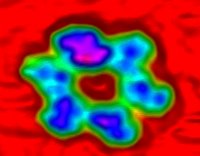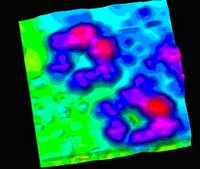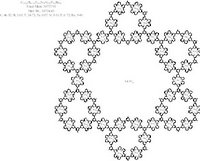Technorati Tags: Nanofibers or Nanotubes and Nano or Nanotechnology and nanoparticles or Nanotech and Nanopore or nanochemistry and nanoscale or nanowires and nanogenerators or nano test tubes and Quantum Phenomena or Synthetic Nanoscale Fractal Molecule and nanostructures or Nanoscience
Scientists Create the First Synthetic Nanoscale Fractal Molecule, Thursday May 11, 2006 by ANDREA GIBSON
 |  |  |
The molecule, developed by researchers at the University of Akron, Ohio University and Clemson University, eventually could lead to new types of photoelectric cells, molecular batteries and energy storage, according to the scientists, whose study was published online today by the journal Science.
A University of Akron research team led by Vice President for Research George Newkome used molecular self-assembly techniques to synthesize the molecule in the laboratory. The molecule, bound with ions of iron and ruthenium, forms a hexagonal gasket.
Ohio University physicists Saw-Wai Hla and Violeta Iancu, who specialize in imaging objects at the nanoscale, confirmed the creation of the man-made fractal. To capture the image, the physicists sprayed the molecules onto a piece of gold, chilled them to minus 449 degrees Fahrenheit to keep them stable, and then viewed them with a scanning tunneling microscope.
Though invisible to the naked eye – the molecules are about one million times smaller than the colorful hexagons shown in the Science image – the objects are 12 nanometers wide. “That’s big for a nanoscale molecule. It’s huge,” said Hla, an associate professor of physics and astronomy.
“This man-made structure is one of the first nanoscale, non-branched fractal molecules ever produced,” said Newkome, who is lead author on the Science paper and also serves as dean of the Graduate School and the James and Vanita Oelschlager Professor of Science and Technology at the University of Akron. “Blending mathematics, art and science, these nanoscopic hexagonal-shaped materials can be self-assembled and resemble a fine bead necklace. These precise polymers — the first example of a molecule possessing a ‘Star of David’ motif — may provide an entrée into novel new types of photoelectric cells, molecular batteries and energy storage.”
Fractals are irregular curves or shapes that retain the same pattern when reduced or magnified. The molecule in the study, for example, is composed of six rings, which are made up of six smaller rings, and so on, Hla explained. Snowflakes, broccoli florets or tree bark would be just a few examples from nature.
Hla and Iancu, a graduate student, also were able to measure the electronic structure of the molecule, which is useful to know for possible electronic applications. “(The molecules) are unique in their own way, so you have to find out what kind of properties they have so we can initiate possible applications,” he said.
The study authors were George R. Newkome, Pingshan Wang, Charles N. Moorefield, Tae Joon Cho, Prabhu Mohapatra, Sinan Li, Seok-Ho Hwang and Judith A. Palagallo, all from the University of Akron; Violeta Iancu and Saw-Wai Hla of Ohio University; and Olena Lukoyanova and Luis Echegoyen of Clemson University.
The research was supported by the National Science Foundation, Air Force Office of Scientific Research and the Ohio Board of Regents.
Hla is a member of Ohio University’s Nanoscale & Quantum Phenomena Institute, Condensed Matter and Surface Science group and Biomimetic Nanoscience and Nanotechnology group, which is part of Ohio University’s $8 million NanoBioTechnology Initiative, one of three major research priorities of the institution.
Read the article on Science Express or contact @Science for a copy. Contacts at Ohio University: Saw Wai-Hla, (740) 593-1727, hla@helios.phy.ohiou.edu; Andrea Gibson, (740) 597-2166, gibsona@ohio.edu Media Contact at University of Akron: Ken Torisky, (330) 972-7299.
Related: Keyword Nanotech Sunday, Sunday, May 14, 2006 World’s tiniest test tubes get teensiest corks, Sunday, May 07, 2006 Blood-Compatible Nanoscale Materials Possible Using Heparin, Sunday, April 30, 2006 Micro-pump is cool idea for future computer chips, Sunday, April 16, 2006 Self-Powered Nanoscale Devices, Sunday, April 09, 2006 Nanopore Method Genome Sequencing, Sunday, April 02, 2006 Quantum dot method rapidly identifies bacteria, March 26, 2006 'Custom' nanoparticles, cancer diagnosis and treatment, Sunday, March 26, 2006, Green nanochemistry, American Chemical Society symposium, Sunday, March 19, 2006 nanotechnologists demonstrate artificial muscles powered by highly energetic fuels, Sunday, Sunday, March 12, 2006 magnetic phenomenon may improve RAM memories, February 26, 2006 Nanoscience study shows that quantum dots 'talk', Sunday, February 26, 2006 Nano-bots to undertake major tasks?, Sunday, February 19, 2006 Nanotech to improve health care delivery, Sunday, February 19, 2006 nano-canary in the nanotoxicology coalmine, Sunday, December 04, 2005 Nano-cages 'fill up' with hydrogen, Sunday, November 13, 2005 Testing toxicity of nanomaterials, Sunday, October 23, 2005 single-molecule car, 'Nanocar', Sunday, August 28, 2005 Writing at the nanoscale, Thursday, May 26, 2005 discontinuous palladium, siloxane self-assembled monolayer, Sunday, May 08, 2005 Center for Nanoscale Materials, Monday, April 25, 2005 Nanomagnets, Nanocomposite, Monday, March 21, 2005 porphyrin tubes may lead to new nanodevices, inexpensive hydrogen fuel.











No comments:
Post a Comment